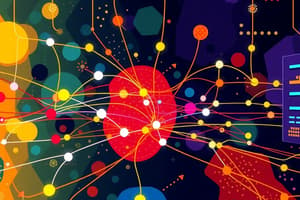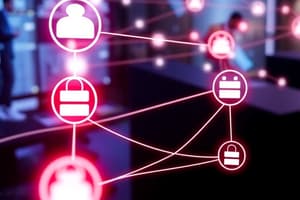Podcast
Questions and Answers
What is an end device
What is an end device
An end device is where a message originates from or where it is received.
What is an intermediary device? Give examples
What is an intermediary device? Give examples
Examples include switches and routers.
What is a server?
What is a server?
They can regenerate and retransmit data signals.
List the 3 media types (material, method of transmission, type of wire)
List the 3 media types (material, method of transmission, type of wire)
What is the difference between physical and logical topology diagrams?
What is the difference between physical and logical topology diagrams?
How do wireless transmissions work as a network media?
How do wireless transmissions work as a network media?
What are the two main types of network security?
What are the two main types of network security?
Explain what is peer-to-peer network , include the disadvantages and advantages
Explain what is peer-to-peer network , include the disadvantages and advantages
Explain the CIA
Explain the CIA
What are some recent trends affecting organizations and consumers?
What are some recent trends affecting organizations and consumers?
In what scenarios are Peer-to-Peer networks most effectively utilized?
In what scenarios are Peer-to-Peer networks most effectively utilized?
Define an intranet and its primary purpose.
Define an intranet and its primary purpose.
What is the primary function of an extranet?
What is the primary function of an extranet?
What problem did converged networks address compared to traditional networks?
What problem did converged networks address compared to traditional networks?
List the main types of services that converged data networks can carry.
List the main types of services that converged data networks can carry.
Explain Fault tolerance
Explain Fault tolerance
Explain Scalability, network security and Quality of Service QoS
Explain Scalability, network security and Quality of Service QoS
Why is Quality of Service (QoS) important for services like voice and video?
Why is Quality of Service (QoS) important for services like voice and video?
In the context of network services, what could cause interruptions in live video transmissions?
In the context of network services, what could cause interruptions in live video transmissions?
What is one major drawback of circuit-switched networks compared to packet-switched networks?
What is one major drawback of circuit-switched networks compared to packet-switched networks?
Explain what LANs and WANs are
Explain what LANs and WANs are
How do LANs and WANs work together to form the internet?
How do LANs and WANs work together to form the internet?
What causes network infrastructures to vary?
What causes network infrastructures to vary?
What types of cables may WANs use for transmission?
What types of cables may WANs use for transmission?
In terms of administration, how are LANs and WANs typically managed?
In terms of administration, how are LANs and WANs typically managed?
Flashcards
Network
Network
A system of interconnected devices that allows communication and information sharing.
Host
Host
Any computer on a network.
Server
Server
A computer that provides information (e.g., email, web pages, files) to other computers (clients).
Client
Client
Signup and view all the flashcards
Peer-to-Peer Network
Peer-to-Peer Network
Signup and view all the flashcards
Advantages of Peer-to-Peer
Advantages of Peer-to-Peer
Signup and view all the flashcards
Disadvantages of Peer-to-Peer
Disadvantages of Peer-to-Peer
Signup and view all the flashcards
End Device
End Device
Signup and view all the flashcards
LAN
LAN
Signup and view all the flashcards
Intermediary Device
Intermediary Device
Signup and view all the flashcards
WAN
WAN
Signup and view all the flashcards
Home Network
Home Network
Signup and view all the flashcards
Network Media
Network Media
Signup and view all the flashcards
Network Diagram
Network Diagram
Signup and view all the flashcards
SOHO Network
SOHO Network
Signup and view all the flashcards
Physical Topology
Physical Topology
Signup and view all the flashcards
Medium/Large Network
Medium/Large Network
Signup and view all the flashcards
Logical Topology
Logical Topology
Signup and view all the flashcards
World Wide Network
World Wide Network
Signup and view all the flashcards
Internet
Internet
Signup and view all the flashcards
Network Interface Card (NIC)
Network Interface Card (NIC)
Signup and view all the flashcards
Physical Port
Physical Port
Signup and view all the flashcards
Interface
Interface
Signup and view all the flashcards
IETF
IETF
Signup and view all the flashcards
ICANN
ICANN
Signup and view all the flashcards
IAB
IAB
Signup and view all the flashcards
Intranet
Intranet
Signup and view all the flashcards
Extranet
Extranet
Signup and view all the flashcards
Converged Networks
Converged Networks
Signup and view all the flashcards
Network Architecture
Network Architecture
Signup and view all the flashcards
Fault Tolerance
Fault Tolerance
Signup and view all the flashcards
Scalability
Scalability
Signup and view all the flashcards
Quality of Service (QoS)
Quality of Service (QoS)
Signup and view all the flashcards
Packet Switching
Packet Switching
Signup and view all the flashcards
Circuit Switching
Circuit Switching
Signup and view all the flashcards
Reliable Network Characteristics
Reliable Network Characteristics
Signup and view all the flashcards
Network Security
Network Security
Signup and view all the flashcards
Confidentiality
Confidentiality
Signup and view all the flashcards
Integrity
Integrity
Signup and view all the flashcards
Availability
Availability
Signup and view all the flashcards
BYOD
BYOD
Signup and view all the flashcards
Network Infrastructure Security
Network Infrastructure Security
Signup and view all the flashcards
Physical Security
Physical Security
Signup and view all the flashcards
Information Security
Information Security
Signup and view all the flashcards
Study Notes
Module 1: Networking Today
- Networking is essential, comparable to basic needs like air, water, food, and shelter.
- Modern networks connect people globally like never before.
- Networks affect daily life by enabling communication and connection.
Networking Today: No Boundaries
- Networks transcend geographical limitations.
- Networks facilitate global communities.
- The modern network is a human network uniting individuals.
Network Components: Host Roles
- Every computer on a network is a host or end device.
- Servers provide information to end devices.
- Email servers provide email services.
- Web servers provide web page access.
- File servers store files.
- Clients request and retrieve information from servers.
Network Components: Peer-to-Peer
- A device can be both a client and a server.
- This design is best for small networks.
- Advantages include ease of setup, simplicity, and lower cost.
- Drawbacks include lack of centralized administration, security concerns, and limited scalability.
- Suitable for simple tasks like file sharing and printer sharing.
Network Components: End Devices
- End devices initiate and receive data.
- Data travels through the network from a sending end device to a receiving end device.
- LANs (Local Area Networks) are part of the complete network.
- Internetworks can allow alternate routes between connected LANs.
Network Components: Intermediary Devices
- Intermediary devices connect end devices.
- Examples include switches, wireless access points, routers, and firewalls.
- Intermediary devices manage data flow, including regenerating and retransmitting signals and maintaining network pathways.
- They notify other devices about errors or communication failures.
Network Components: Network Media
- Data travels across a network through a medium, allowing messages to pass from source to destination.
- Types of Media include metal wires(copper), glass or plastic fibers(fiber optic), and wireless.
Network Representations and Topologies
- Network diagrams, also known as topology diagrams, use symbols to represent network devices.
- Terms like physical port, network interface card, and interface are commonly used.
- Physical topology diagrams show the physical arrangement of devices and cable installations.
- Logical topology diagrams depict the devices, ports, and addressing scheme of the network.
Common Types of Networks
- Networks vary in size, user count, services, and responsibility areas.
- Network types include small home networks, small office/home office (SOHO), medium/large networks, and wide area networks (WANs).
- WANs connect many networks.
- LANs interconnect devices in a limited physical area.
Common Types of Networks: LANs and WANs
- LAN covers a small geographical area, usually managed by a single organization.
- WANs span larger geographical areas, often maintained by multiple service providers.
- WANs typically connect several LANs.
Common Types of Networks: The Internet
- The internet is a collection of interconnected LANs and WANs worldwide.
- LANs and WANs use copper, fiber optic, and wireless transmission.
- The internet isn't owned by any single entity. Organizations like the IETF, ICANN, and IAB help maintain internet structure.
Common Types of Networks: Intranets and Extranets
- Intranets are private LAN/WAN collections internal to a company. Access is restricted to authorized members.
- Extranets allow secure access to an organization's network from outside individuals or other organizations.
Internet Connections: The Converging Network
- Before converged networks, organizations used separate networks for telephone, video, and data.
- Each technology used a unique set of rules and standards.
Internet Connections: The Converging Network (Cont.)
- Converged networks allow data, voice, and video to share the same network infrastructure.
- This uses the same rules and standards.
Reliable Networks
- Quality of Service (QoS), fault tolerance, scale, and security are vital qualities in a robust network.
- Scalability lets networks accommodate more users and applications without compromising performance.
- Fault tolerance reduces the impact of failures by using alternative paths.
- Security protects the network infrastructure from unauthorized access or data breaches.
Network Trends
- Recent trends affect the role of networks, necessitating ongoing adjustments.
- Several recent trends that impact networks, include bring your own device (BYOD), online collaboration, video communications, and cloud computing.
- These trends constantly impact and change networks allowing flexibility to support future technologies
Studying That Suits You
Use AI to generate personalized quizzes and flashcards to suit your learning preferences.




